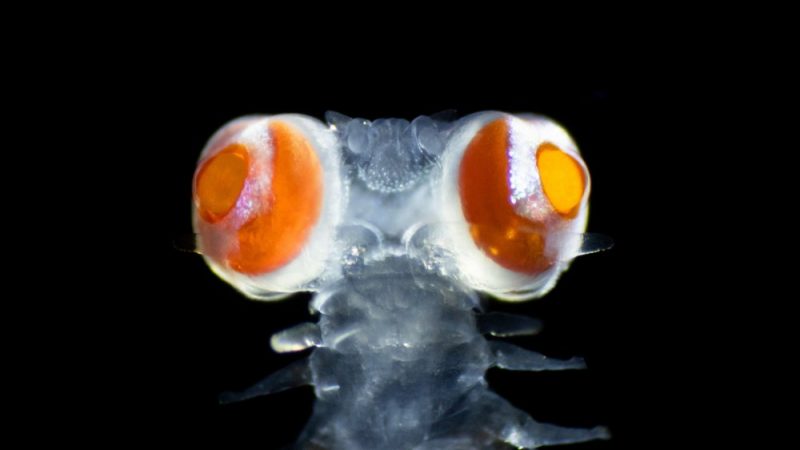Tiny worm with enormous eyes may have a ‘secret language’

Worm bodies might not seem all that interesting. However, a closer look can also reveal how some worms use extra appendages to move through the water like “magic carpets,” while others detach their butts to procreate. Scientists have now discovered that a type of bristle worm is equipped with a complex vision system dominated by two really big eyes.
The Vanadis bristle worm’s eyes can potentially use ultraviolet (UV) light to communicate and find mates and/or food, which has not been well documented or studied in nature. The worms could also be among the only known bioluminescent animals that use UV light to glow. The findings are described in a study published April 8 in the journal Current Biology.
Meet Vanadis bristle worms
The Vanadis bristle worms in this study are found around the island of Ponza, in the Mediterranean Sea west of Naples, Italy. It is a member of a family of large-eyed bristle worms called polychaeta. They are about six inches long and primarily eat plankton, algae, and bits of organic matter from dead organisms. As a pair, the worm’s eyes weigh about 20 times as much as the rest of the worm’s head, and appear like two giant red orbs are strapped to its body. If human eyes are as proportionally large, we would need to carry around roughly 220 extra pounds. Since the worms are nocturnal and disappear when the sun is out, scientists wondered what they do with their eyes after and what they are used for.
[Related: How do animals see the world?]
In the study, a team from the University of Copenhagen in Denmark, Lund University in Sweden, and Tuscia University in Italy examined three species of bristle worms that they collected by hand in shallow water. They brought them back to a lab, where they analyzed their eyes in close detail. The team found that Vanadis’ eyesight is better and more advanced than previously believed. Its eyes can see very small objects and track their movements, despite having a more simple nervous system.
A ‘secret language’–for mating
The team is still trying to figure out how they evolved such sharp eyesight. The worms’ bodies are transparent, except for their eyes that need to register light to work properly. This means that they can’t be inherently transparent, so their eyes becoming visible must come with some evolutionary trade-offs. Some aspects about having a transparent body with visible eyes must have had evolutionary benefits that outweigh the consequences.
What the worms gain remains unclear partially because they do not come out during the day, when eyes typically work best.
“No one has ever seen the worm during the day, so we don’t know where it hides. So, we cannot rule out that its eyes are used during the day as well,” University of Copenhagen marine and neurologist Anders Garm said in a statement. “What we do know is that its most important activities, like finding food and mating, occur at night. So, it is likely that this is when its eyes are important.”
[Related: Microscopic worms use electricity to ride bumblebees like EVs.]
The team believes that part of the explanation is that these worms can see different wavelengths of light than humans can. Like many birds, reindeer, and other more complex organisms, the worm’s vision can see UV light that is invisible to the human eye. This could indicate that the purpose of the eyes is to see bioluminescent signals in the pitch-black night time sea. Bioluminescence occurs when organisms can produce light on their own. Glow-worms are a famous example that use certain chemicals to produce light within their bodies.
“We have a theory that the worms themselves are bioluminescent and communicate with each other via light. If you use normal blue or green light as bioluminescence, you also risk attracting predators,” said Garm. “But if instead, the worm uses UV light, it will remain invisible to animals other than those of its own species. Therefore, our hypothesis is that they’ve developed sharp UV vision so as to have a secret language related to mating.”
The worms also may need to be on the lookout for UV bioluminescent prey. Regardless of what it is used for, the Vanadis worm could become the first animal proven to naturally create UV bioluminescence to communicate, according to Garm.
Robotics research and evolutionary debates
The team has begun working with robotics researchers from the University of Southern Denmark to investigate how to better understand the mechanism behind these eyes well enough to translate it into technology.
“Together with the robotics researchers, we are working to understand how animals with brains as simple as these can process all of the information that such large eyes are likely able to collect,” said Garm. “This suggests that there are super smart ways to process information in their nervous system. And if we can detect these mechanisms mathematically, they could be integrated into computer chips and used to control robots.”
Beyond robotics, their eyes could also help settle a heavy debate around evolutionary theory. Did eyes only evolve once into every form we know today or have they arisen several times in evolutionary history?
Vanadis has eyes that are built relatively simply, but have very advanced functions. They have simultaneously evolved in only a few million years–a relatively short span of time in terms of evolution. These worm eyes likely developed independently of more complex eyes like humans, and could help prove that the development of vision is possible over a relatively short time.










